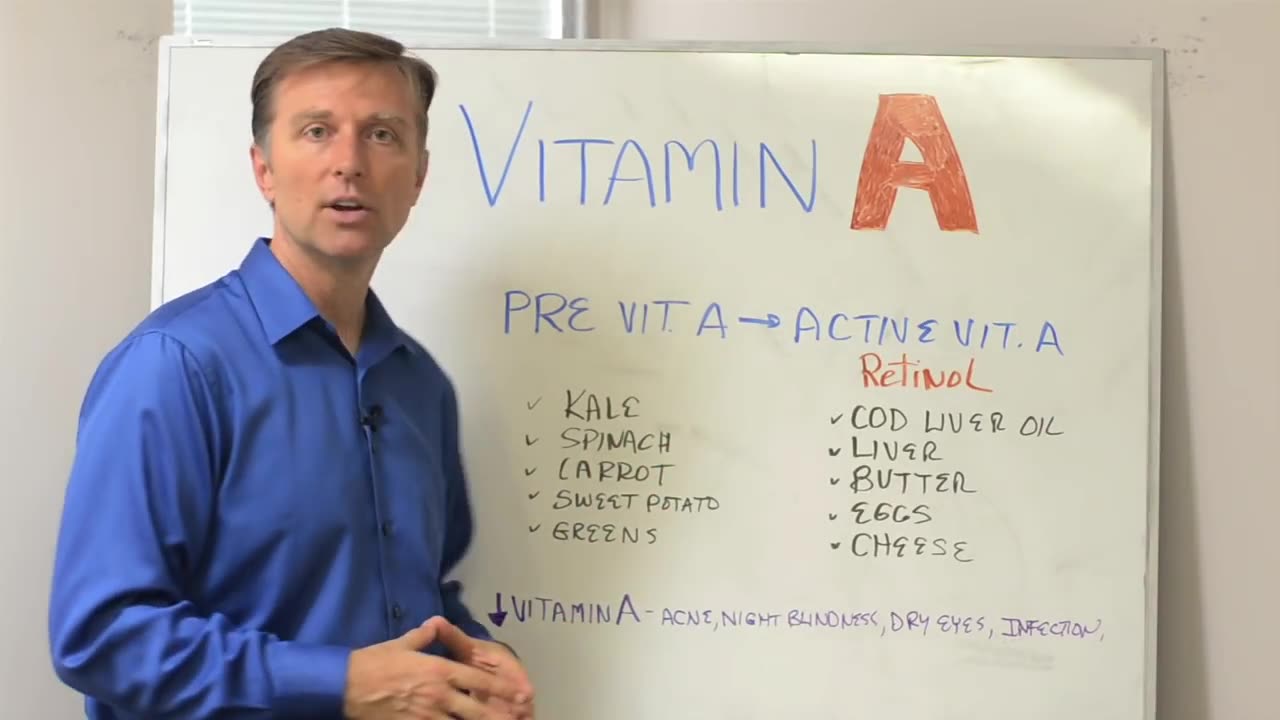Premium Only Content

Vitamin A: Sources, Functions, and Deficiencies
In this video, we’re going to cover vitamin A functions, sources, and vitamin A deficiencies.
Vitamin A is a fat-soluble vitamin. This means it has the ability to travel through fat, and it can be stored in fat longer. Fat-soluble vitamins can go right through a cell. Water-soluble vitamins can’t do this. Fat-soluble vitamins can affect the deep parts of the cell and DNA.
Vitamin A deficiencies can affect what your skin turns into at the genetic level. Symptoms of a vitamin A deficiency can include:
• Flaky skin
• White dots on the skin
• Dandruff
• Vision problems (night blindness)
• Infections
• Lack of lubrication of the eye or mouth
Great vitamin A sources:
• Cod liver oil
• Liver
• Butter
• Eggs (especially the yolk)
• Cheese
There are also foods that have previtamin A. This means it has to be converted into the active form a vitamin A. This conversion only takes place in certain parts of the body at certain percentages.
Sources of previtamin A:
• Kale
• Spinach
• Carrots
• Sweet potatoes
• Greens
What causes a vitamin A deficiency?
• Not consuming foods rich in the active form of vitamin A
• Not converting previtamin A to the active form (this has to do with a digestive issue)
• A lack of bile
• A congested liver
Dr. Eric Berg DC Bio:
Dr. Berg, age 57, is a chiropractor who specializes in Healthy Ketosis & Intermittent Fasting. He is the author of the best-selling book The Healthy Keto Plan, and is the Director of Dr. Berg Nutritionals. He no longer practices, but focuses on health education through social media.
-
 1:57:34
1:57:34
Kim Iversen
6 hours agoRFK Jr., Tulsi, Kash Patel SHRED Senate Clowns—Democrats Humiliated!
64.4K76 -
 LIVE
LIVE
Laura Loomer
3 hours agoEP 97: Trump's Nominees Transform America
2,362 watching -
 DVR
DVR
Man in America
10 hours agoThe Helicopter Crash DOESN'T MAKE SENSE... What REALLY Happened???
15.1K25 -
 55:11
55:11
Flyover Conservatives
22 hours agoParents WIN, Teachers Unions PANIC! 3 Huge Education Bombshells This Week! - Corey DeAngelis | FOC Show
17.4K -
 1:40:20
1:40:20
Glenn Greenwald
6 hours agoTulsi's Hearing Exposes Bipartisan Rot of DC Swamp | SYSTEM UPDATE #400
78.4K173 -
 1:19:48
1:19:48
Simply Bitcoin
11 hours ago $0.64 earnedJerome Powells MASSIVE Bitcoin Backflip! | EP 1172
42K3 -
 58:42
58:42
The StoneZONE with Roger Stone
3 hours agoLBJ + CIA + Mob + Texas Oil = JFK Murder | The StoneZONE w/ Roger Stone
31.3K11 -
 58:00
58:00
Donald Trump Jr.
10 hours agoBreaking News on Deadly Plane Crash, Plus Hearing on the Hill, Live with Rep Cory Mills & Sen Marsha Blackburn | TRIGGERED Ep.212
164K123 -
 52:03
52:03
Kimberly Guilfoyle
9 hours agoLatest Updates on Deadly Air Collision, Plus Major Hearings on Capitol Hill,Live with Marc Beckman & Steve Friend | Ep.192
92.1K29 -
 1:17:16
1:17:16
Josh Pate's College Football Show
7 hours ago $0.89 earnedMichigan vs NCAA | ESPN’s ACC Deal | Season Grades: UGA & Miami | Notre Dame Losses
34.8K2